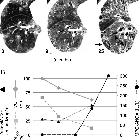microscopic polyangiitis


Microscopic polyangiitis (MPA) is small vessel non-granulomatous necrotizing vasculitis. It most often affects venules, capillaries, arterioles, and small arteries, although it occasionally involves medium-sized arteries.
Epidemiology
It typically affects middle-aged individuals.
Clinical presentation
This condition can affect multiple organ systems. Common sites of involvement are:
- kidneys: necrotizing glomerulonephritis (present in ~90% of cases )
- lungs: pulmonary capillaritis
- skin: purpura
- gastrointestinal tract
Pathology
It is histologically very similar to polyarteritis nodosa except for involvement of vessels smaller than arteries (e.g. arterioles, venules, capillaries)
There is an absence or paucity of immunoglobulin localization in vessel walls which distinguishes MPA from immune complex-mediated small vessel vasculitis (e.g. Henoch-Schonlein purpura and cryoglobulinaemic vasculitis)
Markers
- pANCA-positive in a significant (~70-90%) proportion of cases
Subtypes
Some classify two conditions as organ-specific subsets of this condition :
- lung-isolated idiopathic pauci-immune pulmonary capillaritis
- kidney-idiopathic pauci-immune rapidly progressive glomerulonephritis (RPGN)
Radiographic features
Pulmonary involvement
There can be a spectrum of findings which typically include pulmonary hemorrhage:
- diffuse pulmonary hemorrhage: seen in 30-40% of cases
- hemorrhages can be relapsing
Other described manifestations (which are non-specific as individual features) include :
- regions of ground-glass attenuation
- pulmonary consolidation
- thickening of bronchovascular bundles
- features of interstitial pneumonitis / pulmonary fibrosis
Treatment and prognosis
Treatment options in severe forms usually include methylprednisolone +/- cyclophosphamide. Other management options include tumor necrosis factor-alpha blockers rituximab, and nonpharmacologic modalities such as plasmapheresis and ventilatory management .
With treatment, there is often complete remission of the disease in a majority of cases.
Differential diagnosis
The differential can be broad dependent on the type of manifestations and feature.
For lung involvement consider:
- eosinophilic granulomatosis with polyangiitis:
- has asthma and eosinophilia
- granulomatosis with polyangiitis:
- granulomatous vasculitis
- can cavitate
- Goodpasture syndrome
- circulating antiglomerular basement membrane (anti-GBM)
- pulmonary hemorrhage (ground glass, airspace opacities and reticular "crazy paving")
History and etymology
It is thought to have been initially described by Friedrich Wohlwill (1881-1958), a German physician, in 1923 .
See also
Siehe auch:
- Polyarteriitis nodosa
- Churg-Strauss-Syndrom
- Granulomatose mit Polyangiitis
- Lungenfibrose
- Aortitis
- pulmonale Vaskulitis
und weiter:

 Assoziationen und Differentialdiagnosen zu Mikroskopische Polyangiitis:
Assoziationen und Differentialdiagnosen zu Mikroskopische Polyangiitis:





